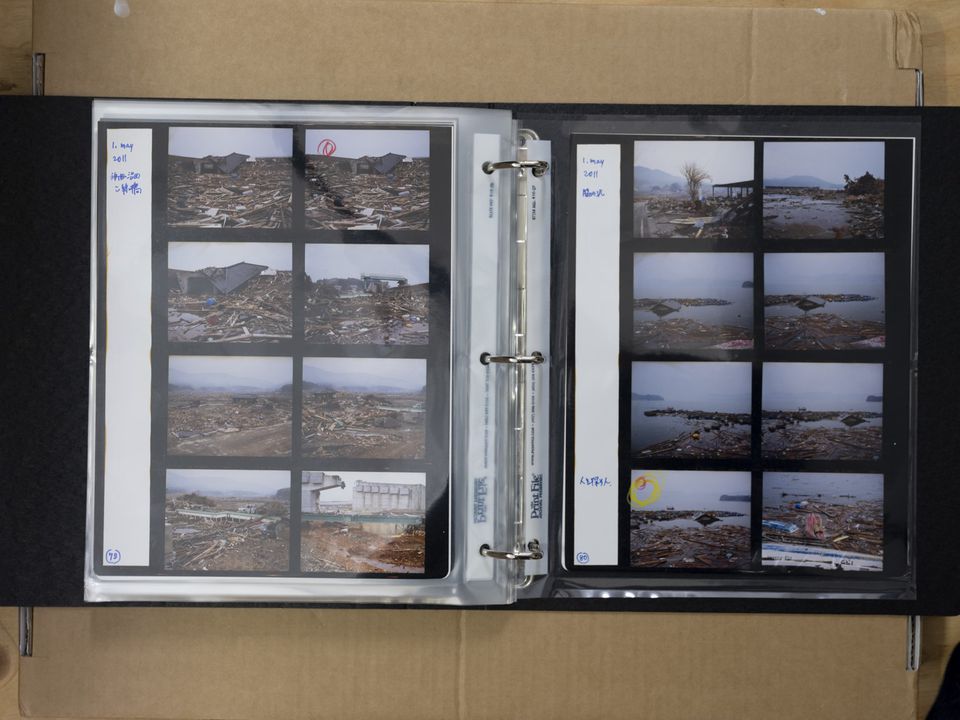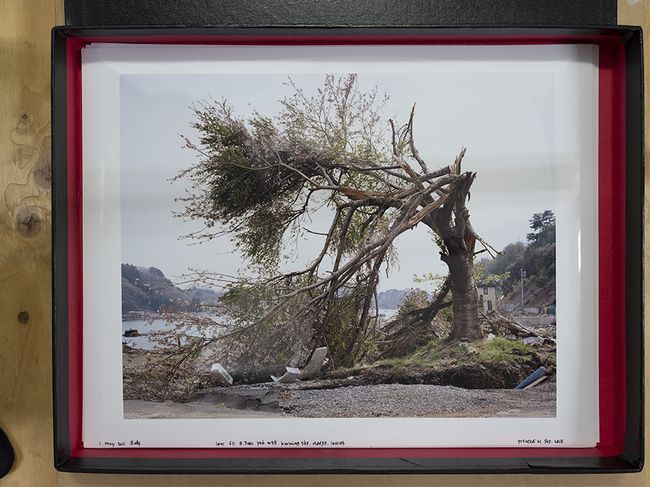Unintended Memories
Naoya Hatakeyama in conversation with Stefano Graziani and Bas Princen
This oral history was filmed by Jonas Spriestersbach in December 2022 at Naoya Hatakeyama’s studio in Tokyo. It is part of the CCA project The Lives of Documents—Photography as Project, an open reflection on how past and contemporary image-making practices serve as critical tools to read our built environment and design today’s world.





- BP
- What is the order of the images you photographed in Kesengawa? The first two-thirds of the book are photographs of the area where you grew up, taken before the tsunami of 2011, almost as a personal record of your memories of the landscape. What changed for you in photographing a very personal place—your hometown before and after the tsunami? Do you feel responsible toward the subject? Does it connect at all to your older work on architecture?
- NH
- The tsunami was a significant event in my life, and it’s impossible to express how I feel about it in simple words. I want to explain its impact on me as simply as possible, but this is difficult because important and unimportant things are mixed up in my mind, as are different feelings.
When I photographed the images in this book, I didn’t think at all about the history of photography. When I display my works in a gallery or a museum, I always think about their place in the history of photography and how they relate to great artists and contemporary photographers. But I didn’t think about other artists for this project. - BP
- Do you consider these images as snapshots, memories that you didn’t know would become memories?
- NH
- Yeah, whenever I returned to my hometown, I carried a 6 × 7 inch camera. I would photograph just for fun.
- BP
- And you put one of these snapshots on the cover of the Japanese edition.
- NH
- It is a beautiful picture to me, one that connects to my childhood memory of my neighbourhood.
RIKUZENTAKATA (2011 – )
Life of the Project
2011
Immediately after the earthquake and tsunami that hit eastern Japan on 11 March, Hatakeyama travelled to his hometown, Rikuzentakata, to document their impact
2011–2012
Exhibition:
Natural Stories
Organized at the Tokyo Photographic Art Museum, Tokyo, Japan (2011); Huis Marseille, Amsterdam, Netherlands (2011); and SFMOMA, San Francisco, USA (2012)
2012
Exhibition: Architecture. Possible Here? Home-for-all
Represented Japan at the 13th Venice Biennale of Architecture, Venice, Italy
29 August – 25 November 2012
2012
Publication:
気仙川 Kesengawa
Published by Kowade Shobo Shinsha, Tokyo, Japan
2013
Publication:
気仙川 Kesengawa
The French/English edition of the 2012 book
Published by Light Motiv, Lille, France
A related exhibition was organized at the Espace Le Carré, Lille, France
2015
Exhibition:
陸前高田 Rikuzentakata (2011–2014)
Organized at Ginza Nikon Salon, Tokyo and Osaka Nikon Salon, Osaka, Japan
3 March – 25 April 2015 and 4 April – 30 May 2015
2015
Publication:
陸前高田 Rikuzentakata (2011–2014)
Published by Kowade Shobo Shinsha, Tokyo, Japan
2015
Exhibition:
In the Wake: Japanese Photographers Respond to 3/11
Organized by the Museum of Fine Arts, Boston, USA
5 April – 12 July 2015
2016
Publication:
陸前高田 Rikuzentakata
Published by Light Motiv, Lille, France
2016
Publication:
出来事と写真Events and Photos
Published by AKAAKA Art Publishing, Tokyo, Japan
2017
Publication:
Cloven Landscape
Published by AKAAKA Art Publishing, Tokyo, Japan
2018
Exhibition:
Naoya Hatakeyama. Rikuzentakata
Organized at Le Lieu Unique, Nantes, France
6 September – 4 November 2018
2021
Essay:
心の陸前高田 Rikuzentakata of the Heart
Published in the April issue of 新潮 Shincho Magazine
2021
Exhibition: 陸前高田 Rikuzen Takata 2011–2020
Organized at the Tokyo Biennale, Tokyo, Japan
10 July – 5 September 2021
2022
Publication:
見えているパチリ!I can see it!
Published by Katari Coco Bunko, texts by Naoya Hatakeyama and Akiko Otake
2022
Publication:
陸前高田市東日本大震災遺構
Memorial Ruins of 2011 Tohoku Earthquake in Rikuzentakata
Two volumes, published by AKAAKA Art Publishing, Tokyo, Japan
- NH
- I took these photographs for personal reasons, but now they’re shared in the book series. So, the meaning of these pictures changed after the earthquake and tsunami. It’s not only my story now, you know? If the earthquake and tsunami hadn’t happened, these pictures would have remained in a box, and people would never have seen them. But because they did, these pictures are now in magazines, and they suddenly acquired a new value. It’s impressive.
- BP
- It also means that they are no longer only for you but for everyone. If you had only included pictures after the tsunami, the project might have been mistaken as something spectacular, which, of course, it is not. By including the snapshots photographed before the tsunami as places and moments that have disappeared and won’t come back, you emphasize that the book is not about what happened but about how disasters are understood on a personal level. How do you understand the juxtaposition of photographs you took before and after the disaster?
- NH
- The book includes a text about my journey back to my hometown after the disaster. I had no information, so I headed there on my motorbike on a winter day. I didn’t know that my mother had died. During my trip, I wrote about what I was thinking, the images I had in my head about what had happened and what I’d find there. I wanted to contrast the images before and after the disaster to show this fantasy of a place that no longer exists. This landscape is lost. I inserted a blank page to divide and contrast the two categories of images. My memories are placed before the white page, and the realities I saw in front of my eyes are placed after.
- BP
- Did this project change your understanding of photography or what a photograph can do?
- NH
- There are things that people can and cannot do, and photography provides a means to document that fact. You intentionally create some photographs and take others without knowing they will be very important. The reception of Kesengawa and Rikuzentakata is something that I couldn’t control. I did not create this project intentionally. If art is about creation, this is not a work of art.
- BP
- Can it be a work of art for others?
- NH
- It’s up to them. It’s their freedom.
- BP
- But do you prefer viewers to see it as a document?
- NH
- I want people to see the pictures. That’s all.
- SG
- Visually, your work has much in common with photojournalism but is not photojournalistic.
- NH
- No, because my experience drove it. My photos might share a visual appearance with photojournalism, but the meaning differs. The typical photojournalist is skilled at capturing an emotional moment. I want people to focus on my photography. That’s why I don’t want to stress my story. When people talk about the tsunami, they refer to 2011. But the event was 11 years ago, and I’ve continued to photograph the reconstruction and recovery of my neighourhood. I think we need more time to think about what happened, so it’s important not to stress the narrative or emotion too much.
- BP
- As a photographer, what can you do after this long experience? The project has been a big part of your life for over 11 years.
- NH
- Well, I can take a new photograph. I can start a new work, even if it’s a single photograph. It’s very important to keep taking photos.

